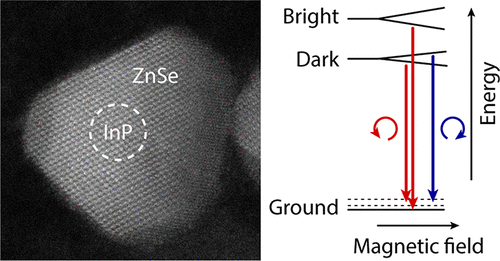当前位置:
X-MOL 学术
›
ACS Photonics
›
论文详情
Our official English website, www.x-mol.net, welcomes your feedback! (Note: you will need to create a separate account there.)
Exciton Fine Structure and Lattice Dynamics in InP/ZnSe Core/Shell Quantum Dots.
ACS Photonics ( IF 7 ) Pub Date : 2018-07-17 , DOI: 10.1021/acsphotonics.8b00615 Annalisa Brodu 1 , Mariana V Ballottin 2 , Jonathan Buhot 2 , Elleke J van Harten 1 , Dorian Dupont 3 , Andrea La Porta 4 , P Tim Prins 1 , Mickael D Tessier 3 , Marijn A M Versteegh 5 , Val Zwiller 5 , Sara Bals 4 , Zeger Hens 3 , Freddy T Rabouw 1 , Peter C M Christianen 2 , Celso de Mello Donega 1 , Daniel Vanmaekelbergh 1
ACS Photonics ( IF 7 ) Pub Date : 2018-07-17 , DOI: 10.1021/acsphotonics.8b00615 Annalisa Brodu 1 , Mariana V Ballottin 2 , Jonathan Buhot 2 , Elleke J van Harten 1 , Dorian Dupont 3 , Andrea La Porta 4 , P Tim Prins 1 , Mickael D Tessier 3 , Marijn A M Versteegh 5 , Val Zwiller 5 , Sara Bals 4 , Zeger Hens 3 , Freddy T Rabouw 1 , Peter C M Christianen 2 , Celso de Mello Donega 1 , Daniel Vanmaekelbergh 1
Affiliation

|
Nanocrystalline InP quantum dots (QDs) hold promise for heavy-metal-free optoelectronic applications due to their bright and size-tunable emission in the visible range. Photochemical stability and high photoluminescence (PL) quantum yield are obtained by a diversity of epitaxial shells around the InP core. To understand and optimize the emission line shapes, the exciton fine structure of InP core/shell QD systems needs be investigated. Here, we study the exciton fine structure of InP/ZnSe core/shell QDs with core diameters ranging from 2.9 to 3.6 nm (PL peak from 2.3 to 1.95 eV at 4 K). PL decay measurements as a function of temperature in the 10 mK to 300 K range show that the lowest exciton fine structure state is a dark state, from which radiative recombination is assisted by coupling to confined acoustic phonons with energies ranging from 4 to 7 meV, depending on the core diameter. Circularly polarized fluorescence line-narrowing (FLN) spectroscopy at 4 K under high magnetic fields (up to 30 T) demonstrates that radiative recombination from the dark F = ±2 state involves acoustic and optical phonons, from both the InP core and the ZnSe shell. Our data indicate that the highest intensity FLN peak is an acoustic phonon replica rather than a zero-phonon line, implying that the energy separation observed between the F = ±1 state and the highest intensity peak in the FLN spectra (6 to 16 meV, depending on the InP core size) is larger than the splitting between the dark and bright fine structure exciton states.
中文翻译:

InP/ZnSe 核/壳量子点中的激子精细结构和晶格动力学。
纳米晶 InP 量子点 (QD) 因其在可见光范围内的明亮且尺寸可调的发射而有望用于无重金属光电应用。通过 InP 核周围的多种外延壳获得光化学稳定性和高光致发光 (PL) 量子产率。为了理解和优化发射线形状,需要研究 InP 核/壳 QD 系统的激子精细结构。在这里,我们研究了 InP/ZnSe 核/壳 QD 的激子精细结构,其核直径范围为 2.9 至 3.6 nm(PL 峰在 4 K 时为 2.3 至 1.95 eV)。作为 10 mK 至 300 K 范围内温度函数的 PL 衰减测量表明,最低激子精细结构状态是暗状态,通过耦合到能量范围为 4 到 7 meV 的受限声子来辅助辐射复合,具体取决于核心直径。高磁场(高达 30 T)下 4 K 的圆偏振荧光窄线 (FLN) 光谱表明,来自暗 F = ±2 状态的辐射复合涉及来自 InP 核和 ZnSe 壳的声学和光学声子. 我们的数据表明,最高强度的 FLN 峰是声子复制品,而不是零声子线,这意味着在 F = ±1 状态和 FLN 光谱中的最高强度峰之间观察到的能量分离(6 到 16 meV,取决于 InP 核心尺寸)大于暗和亮精细结构激子态之间的分裂。高磁场(高达 30 T)下 4 K 的圆偏振荧光窄线 (FLN) 光谱表明,来自暗 F = ±2 状态的辐射复合涉及来自 InP 核和 ZnSe 壳的声学和光学声子. 我们的数据表明,最高强度的 FLN 峰是声子复制品,而不是零声子线,这意味着在 F = ±1 状态和 FLN 光谱中的最高强度峰之间观察到的能量分离(6 到 16 meV,取决于 InP 核心尺寸)大于暗和亮精细结构激子态之间的分裂。高磁场(高达 30 T)下 4 K 的圆偏振荧光窄线 (FLN) 光谱表明,来自暗 F = ±2 状态的辐射复合涉及来自 InP 核和 ZnSe 壳的声学和光学声子. 我们的数据表明,最高强度的 FLN 峰是声子复制品,而不是零声子线,这意味着在 F = ±1 状态和 FLN 光谱中的最高强度峰之间观察到的能量分离(6 到 16 meV,取决于 InP 核心尺寸)大于暗和亮精细结构激子态之间的分裂。来自 InP 核和 ZnSe 壳。我们的数据表明,最高强度的 FLN 峰是声子复制品,而不是零声子线,这意味着在 F = ±1 状态和 FLN 光谱中的最高强度峰之间观察到的能量分离(6 到 16 meV,取决于 InP 核心尺寸)大于暗和亮精细结构激子态之间的分裂。来自 InP 核和 ZnSe 壳。我们的数据表明,最高强度的 FLN 峰是声子复制品,而不是零声子线,这意味着在 F = ±1 状态和 FLN 光谱中的最高强度峰之间观察到的能量分离(6 到 16 meV,取决于 InP 核心尺寸)大于暗和亮精细结构激子态之间的分裂。
更新日期:2018-07-17
中文翻译:

InP/ZnSe 核/壳量子点中的激子精细结构和晶格动力学。
纳米晶 InP 量子点 (QD) 因其在可见光范围内的明亮且尺寸可调的发射而有望用于无重金属光电应用。通过 InP 核周围的多种外延壳获得光化学稳定性和高光致发光 (PL) 量子产率。为了理解和优化发射线形状,需要研究 InP 核/壳 QD 系统的激子精细结构。在这里,我们研究了 InP/ZnSe 核/壳 QD 的激子精细结构,其核直径范围为 2.9 至 3.6 nm(PL 峰在 4 K 时为 2.3 至 1.95 eV)。作为 10 mK 至 300 K 范围内温度函数的 PL 衰减测量表明,最低激子精细结构状态是暗状态,通过耦合到能量范围为 4 到 7 meV 的受限声子来辅助辐射复合,具体取决于核心直径。高磁场(高达 30 T)下 4 K 的圆偏振荧光窄线 (FLN) 光谱表明,来自暗 F = ±2 状态的辐射复合涉及来自 InP 核和 ZnSe 壳的声学和光学声子. 我们的数据表明,最高强度的 FLN 峰是声子复制品,而不是零声子线,这意味着在 F = ±1 状态和 FLN 光谱中的最高强度峰之间观察到的能量分离(6 到 16 meV,取决于 InP 核心尺寸)大于暗和亮精细结构激子态之间的分裂。高磁场(高达 30 T)下 4 K 的圆偏振荧光窄线 (FLN) 光谱表明,来自暗 F = ±2 状态的辐射复合涉及来自 InP 核和 ZnSe 壳的声学和光学声子. 我们的数据表明,最高强度的 FLN 峰是声子复制品,而不是零声子线,这意味着在 F = ±1 状态和 FLN 光谱中的最高强度峰之间观察到的能量分离(6 到 16 meV,取决于 InP 核心尺寸)大于暗和亮精细结构激子态之间的分裂。高磁场(高达 30 T)下 4 K 的圆偏振荧光窄线 (FLN) 光谱表明,来自暗 F = ±2 状态的辐射复合涉及来自 InP 核和 ZnSe 壳的声学和光学声子. 我们的数据表明,最高强度的 FLN 峰是声子复制品,而不是零声子线,这意味着在 F = ±1 状态和 FLN 光谱中的最高强度峰之间观察到的能量分离(6 到 16 meV,取决于 InP 核心尺寸)大于暗和亮精细结构激子态之间的分裂。来自 InP 核和 ZnSe 壳。我们的数据表明,最高强度的 FLN 峰是声子复制品,而不是零声子线,这意味着在 F = ±1 状态和 FLN 光谱中的最高强度峰之间观察到的能量分离(6 到 16 meV,取决于 InP 核心尺寸)大于暗和亮精细结构激子态之间的分裂。来自 InP 核和 ZnSe 壳。我们的数据表明,最高强度的 FLN 峰是声子复制品,而不是零声子线,这意味着在 F = ±1 状态和 FLN 光谱中的最高强度峰之间观察到的能量分离(6 到 16 meV,取决于 InP 核心尺寸)大于暗和亮精细结构激子态之间的分裂。



























 京公网安备 11010802027423号
京公网安备 11010802027423号